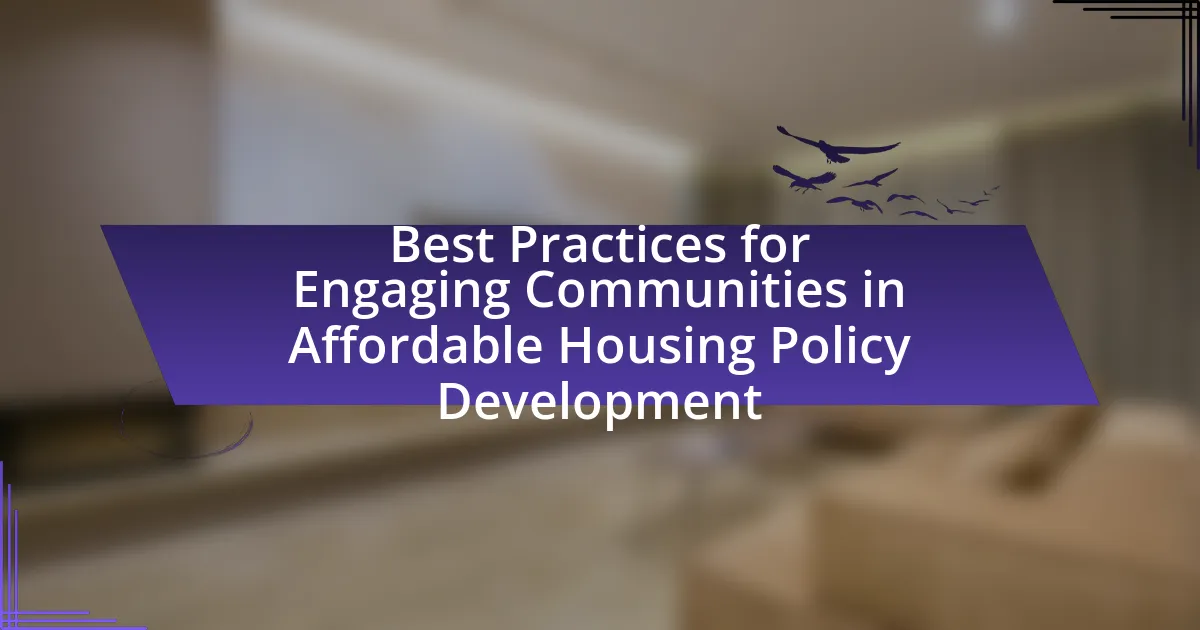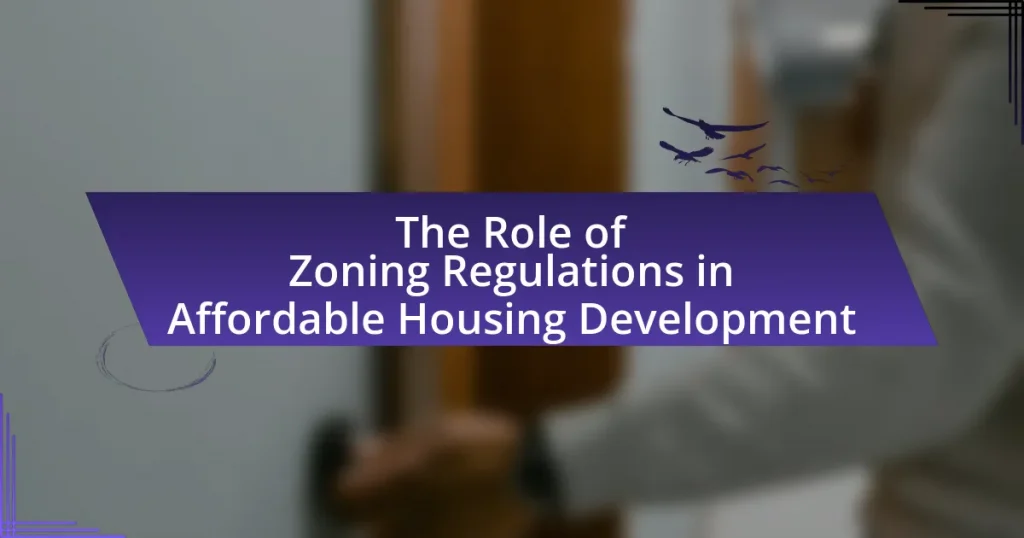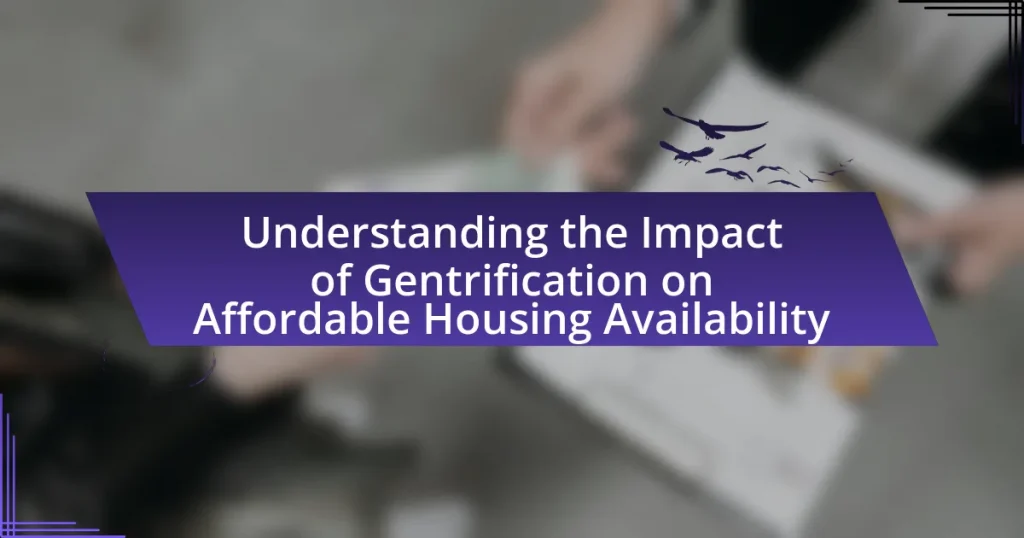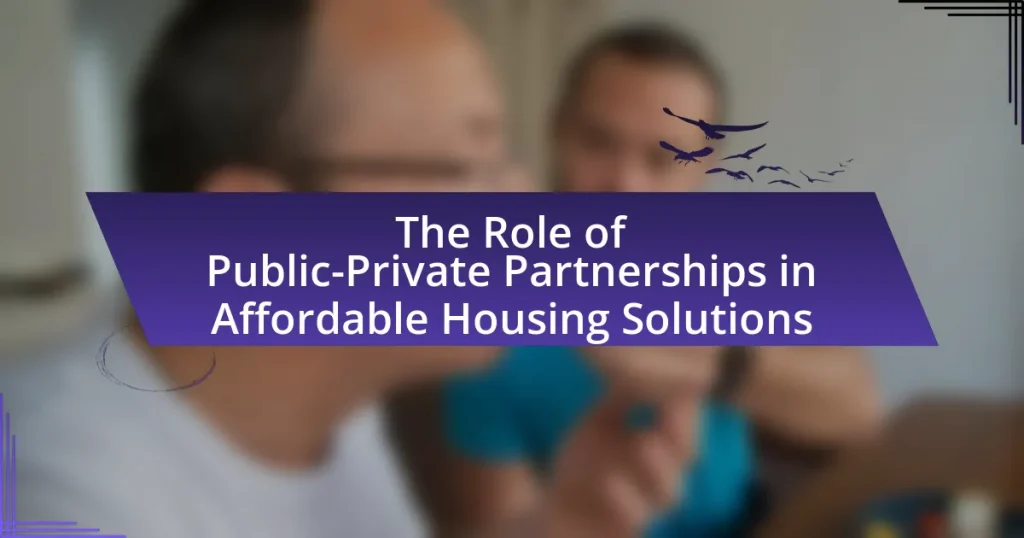The article focuses on best practices for engaging communities in affordable housing policy development. It emphasizes the importance of inclusive participation, transparent communication, and ongoing collaboration among policymakers, community organizations, and residents. Key methods for effective engagement include participatory planning, community workshops, and surveys, which help ensure that housing policies reflect the actual needs and preferences of the community. The article also discusses the challenges faced in community engagement, the role of technology, and the benefits of partnerships with local organizations, ultimately highlighting how effective community engagement leads to more equitable and sustainable housing policies.
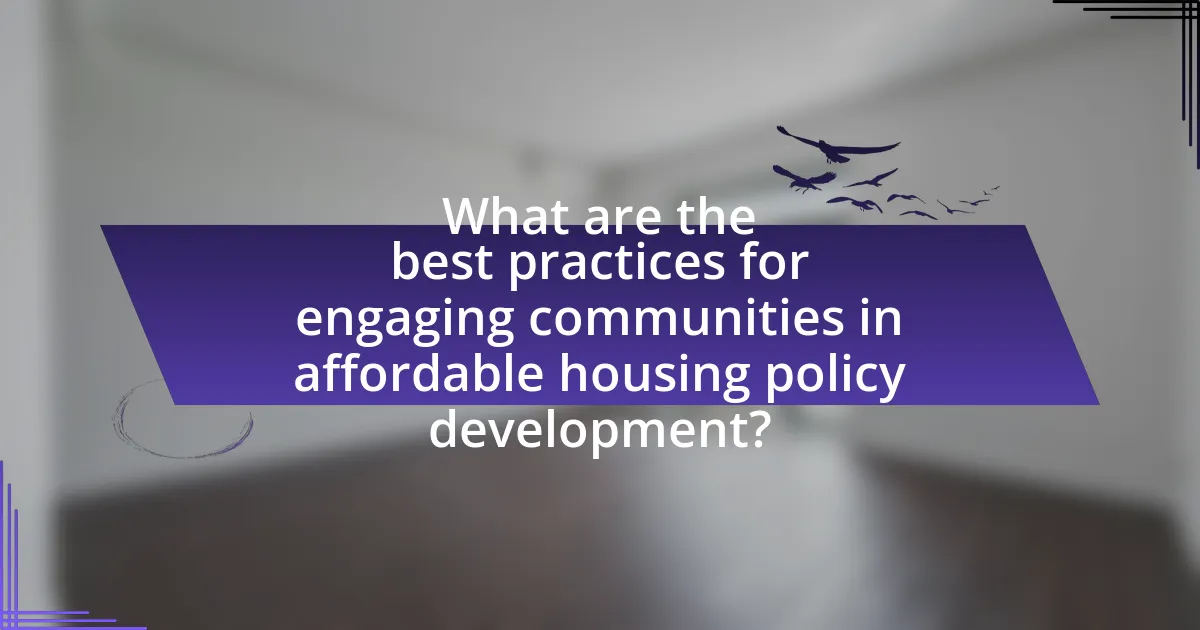
What are the best practices for engaging communities in affordable housing policy development?
The best practices for engaging communities in affordable housing policy development include fostering inclusive participation, utilizing transparent communication, and ensuring ongoing collaboration. Inclusive participation involves actively involving diverse community members, including marginalized groups, in the decision-making process to reflect the community’s needs accurately. Transparent communication ensures that information about housing policies, processes, and impacts is readily accessible and understandable, which builds trust and encourages community involvement. Ongoing collaboration between policymakers, community organizations, and residents helps to sustain engagement and adapt policies based on community feedback. Research by the Urban Institute highlights that effective community engagement leads to more successful and accepted housing policies, demonstrating the importance of these practices in achieving equitable outcomes.
How can community engagement improve affordable housing policy outcomes?
Community engagement can significantly improve affordable housing policy outcomes by ensuring that policies reflect the actual needs and preferences of the community. When local residents participate in the decision-making process, they provide valuable insights that can lead to more effective and targeted housing solutions. For instance, studies have shown that communities involved in the planning stages of housing projects are more likely to support and sustain those initiatives, as evidenced by the success of the Community Land Trust model, which has been effective in various U.S. cities. Engaging residents fosters trust and collaboration between policymakers and the community, ultimately leading to policies that are more equitable and sustainable.
What methods can be used to effectively engage community members?
To effectively engage community members, methods such as participatory planning, community workshops, and surveys can be utilized. Participatory planning involves actively involving community members in the decision-making process, ensuring their voices are heard and valued. Community workshops provide a platform for dialogue, allowing residents to express their needs and concerns directly. Surveys can gather quantitative data on community preferences and priorities, enabling policymakers to tailor solutions that reflect the community’s desires. These methods have been shown to enhance trust and collaboration between community members and policymakers, leading to more successful outcomes in affordable housing policy development.
How does community engagement influence policy decisions?
Community engagement significantly influences policy decisions by ensuring that the voices and needs of the community are reflected in the policies that affect them. When community members actively participate in discussions and decision-making processes, policymakers gain valuable insights into local issues, preferences, and priorities. For instance, research conducted by the Urban Institute highlights that inclusive engagement leads to more effective and equitable housing policies, as it allows for diverse perspectives to shape solutions that are more likely to meet the actual needs of residents. This participatory approach not only enhances the legitimacy of policy decisions but also fosters trust between the community and policymakers, ultimately resulting in more sustainable and accepted outcomes.
Why is community input essential in affordable housing policy development?
Community input is essential in affordable housing policy development because it ensures that the policies reflect the actual needs and preferences of the residents they aim to serve. Engaging the community allows policymakers to gather valuable insights about local housing challenges, preferences for design, and specific demographic needs. Research shows that when communities are involved in the planning process, projects are more likely to succeed and meet the intended goals, as evidenced by a study from the Urban Institute, which found that community engagement leads to higher satisfaction rates among residents and better utilization of housing resources.
What are the potential consequences of neglecting community voices?
Neglecting community voices can lead to ineffective policies that do not address the actual needs of the population. When policymakers ignore the input of community members, they risk creating solutions that are misaligned with local realities, resulting in increased dissatisfaction and potential opposition to initiatives. For instance, a study by the Urban Institute found that community engagement in housing policy leads to better outcomes, as policies developed without local input often fail to meet the specific needs of residents, leading to higher rates of displacement and social unrest.
How can community feedback shape housing policies to meet local needs?
Community feedback can shape housing policies to meet local needs by providing insights into residents’ preferences, challenges, and priorities. Engaging community members through surveys, public meetings, and focus groups allows policymakers to gather specific data on housing demands, such as the need for affordable units or accessibility features. For instance, a study by the Urban Institute found that incorporating community input led to more effective housing solutions that aligned with local demographics and economic conditions. This evidence demonstrates that when policymakers actively listen to community feedback, they can create tailored housing policies that address the unique needs of the population, ultimately leading to improved satisfaction and stability in housing.
What challenges exist in engaging communities for affordable housing policies?
Engaging communities for affordable housing policies faces several challenges, including lack of awareness, diverse stakeholder interests, and mistrust in government processes. Lack of awareness often results in low participation rates, as community members may not understand the importance of their involvement in policy development. Diverse stakeholder interests can lead to conflicting priorities, making it difficult to reach a consensus on housing solutions. Mistrust in government processes can stem from past experiences where community input was overlooked, further discouraging engagement. These challenges are supported by studies indicating that effective community engagement requires addressing these barriers to foster meaningful participation and collaboration in affordable housing initiatives.
What barriers do communities face in participating in policy discussions?
Communities face several barriers in participating in policy discussions, including lack of access to information, limited resources, and systemic inequalities. Access to information is often restricted due to complex policy language and insufficient outreach, which prevents community members from understanding the issues at hand. Limited resources, such as time and funding, hinder participation, particularly for marginalized groups who may prioritize immediate needs over policy engagement. Systemic inequalities, including socioeconomic disparities and historical disenfranchisement, further exacerbate these challenges, making it difficult for certain communities to voice their concerns effectively. These barriers collectively impede meaningful participation in policy discussions, particularly in the context of affordable housing development.
How can policymakers overcome resistance to community engagement?
Policymakers can overcome resistance to community engagement by actively involving community members in the decision-making process. This approach fosters trust and ensures that the concerns and needs of the community are addressed. Research indicates that when community members feel their voices are heard, they are more likely to support initiatives, as demonstrated in the case of the San Francisco Bay Area’s affordable housing policies, where inclusive engagement led to increased community buy-in and reduced opposition. By implementing transparent communication strategies and providing platforms for dialogue, policymakers can effectively mitigate resistance and enhance collaboration.
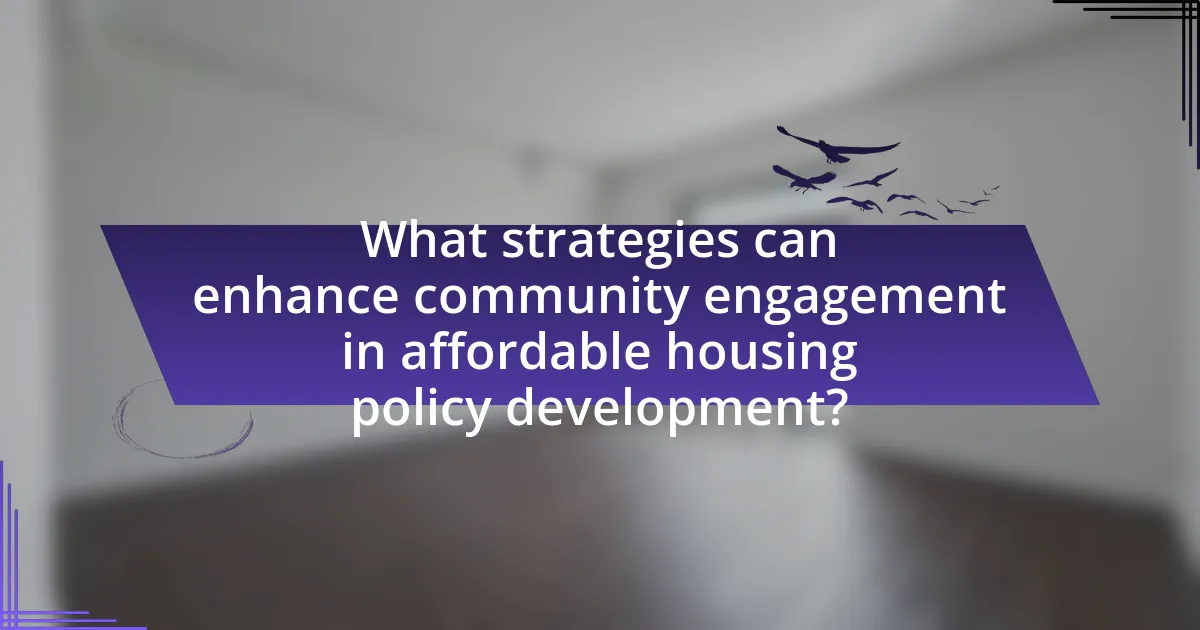
What strategies can enhance community engagement in affordable housing policy development?
Strategies that can enhance community engagement in affordable housing policy development include fostering inclusive dialogue, utilizing technology for outreach, and establishing partnerships with local organizations. Inclusive dialogue ensures that diverse community voices are heard, which can be achieved through public forums and workshops that encourage participation from various demographic groups. Utilizing technology, such as social media and online surveys, allows for broader outreach and engagement, making it easier for residents to share their opinions and experiences. Establishing partnerships with local organizations can leverage existing community trust and networks, facilitating more effective communication and collaboration. Research indicates that communities with strong engagement strategies see higher satisfaction with housing policies and improved outcomes in housing stability.
How can technology facilitate community engagement in housing policy?
Technology can facilitate community engagement in housing policy by providing platforms for communication, data sharing, and feedback collection. Digital tools such as social media, online surveys, and community forums enable residents to express their opinions, share experiences, and participate in discussions about housing issues. For instance, a study by the Urban Institute found that online engagement tools increased participation rates in community meetings by 30%, demonstrating that technology can effectively reach a broader audience. Additionally, geographic information systems (GIS) allow for visual representation of housing data, helping communities understand local needs and advocate for specific policy changes. These technological advancements create more inclusive and informed dialogues around housing policy, ultimately leading to better outcomes for communities.
What digital tools are most effective for gathering community input?
Digital tools most effective for gathering community input include online surveys, social media platforms, and community engagement software. Online surveys, such as SurveyMonkey or Google Forms, allow for the collection of structured feedback from a wide audience, facilitating quantitative analysis of community opinions. Social media platforms like Facebook and Twitter enable real-time interaction and discussion, fostering a sense of community and encouraging diverse viewpoints. Community engagement software, such as Bang the Table or CitizenLab, provides tailored solutions for managing public consultations and feedback processes, ensuring that community voices are heard in policy development. These tools have been shown to enhance participation rates and improve the quality of input received, as evidenced by studies indicating that digital engagement can increase response rates by up to 30% compared to traditional methods.
How can social media be leveraged to engage diverse community groups?
Social media can be leveraged to engage diverse community groups by creating targeted content that resonates with specific demographics and facilitating two-way communication. By utilizing platforms like Facebook, Twitter, and Instagram, organizations can share information about affordable housing policies, gather feedback, and foster discussions that reflect the interests and concerns of various community segments. Research indicates that 69% of adults in the U.S. use social media, making it a vital tool for outreach. Additionally, using features like polls, live Q&A sessions, and community groups can enhance participation and ensure that voices from different backgrounds are heard and valued in the policy development process.
What role do partnerships play in community engagement for housing policies?
Partnerships are essential in fostering community engagement for housing policies by facilitating collaboration between stakeholders, including government agencies, non-profits, and community members. These partnerships enhance the effectiveness of housing policies by ensuring that diverse perspectives and needs are represented, which leads to more inclusive and equitable outcomes. For instance, research by the Urban Institute highlights that collaborative efforts between local governments and community organizations can increase public trust and participation in housing initiatives, ultimately resulting in policies that better reflect community priorities.
How can collaboration with local organizations enhance engagement efforts?
Collaboration with local organizations enhances engagement efforts by leveraging their established trust and relationships within the community. Local organizations often have a deep understanding of community needs and dynamics, which can inform more relevant and effective engagement strategies. For instance, a study by the Urban Institute found that partnerships with local nonprofits increased participation in community meetings by 40%, demonstrating that local organizations can mobilize residents more effectively than external entities. This collaboration not only fosters a sense of ownership among community members but also ensures that diverse voices are heard, leading to more inclusive and representative policy development in affordable housing.
What are the benefits of involving stakeholders in the policy development process?
Involving stakeholders in the policy development process enhances the quality and effectiveness of policies. Stakeholder engagement leads to diverse perspectives, which can identify potential issues and solutions that policymakers may overlook. Research indicates that inclusive policy development increases public trust and buy-in, as stakeholders feel their voices are heard and valued. For instance, a study by the International Association for Public Participation found that projects with stakeholder involvement are 30% more likely to succeed in implementation. Additionally, stakeholder input can improve the relevance and applicability of policies, ensuring they address the actual needs of the community.
How can inclusive practices improve community engagement in housing policy?
Inclusive practices can significantly enhance community engagement in housing policy by ensuring diverse voices are heard and represented in decision-making processes. When housing policy development incorporates input from various community members, including marginalized groups, it fosters a sense of ownership and trust. Research indicates that inclusive engagement leads to more effective policies that reflect the actual needs and preferences of the community, as evidenced by the 2018 report from the Urban Institute, which found that inclusive practices resulted in higher satisfaction rates among residents and better alignment of housing initiatives with community priorities. This approach not only improves the quality of the policies but also strengthens community ties and encourages ongoing participation in future housing discussions.
What strategies can ensure marginalized voices are heard in policy discussions?
To ensure marginalized voices are heard in policy discussions, implementing inclusive engagement strategies is essential. These strategies include establishing community advisory boards that represent diverse demographics, conducting outreach through trusted local organizations, and utilizing participatory budgeting processes that empower community members to influence funding decisions. Research shows that when marginalized groups are actively involved in policy-making, such as through the use of community forums and surveys, their perspectives lead to more equitable outcomes. For instance, a study by the Urban Institute highlights that inclusive practices in housing policy development result in better alignment with community needs and priorities, ultimately fostering more effective and sustainable policies.
How can cultural competency enhance engagement with diverse communities?
Cultural competency enhances engagement with diverse communities by fostering understanding and respect for different cultural backgrounds, which leads to more effective communication and collaboration. When individuals and organizations demonstrate cultural competency, they can better identify and address the unique needs and concerns of various community members, thereby increasing trust and participation in initiatives. Research indicates that culturally competent approaches in community engagement can result in higher levels of involvement and satisfaction among diverse populations, as evidenced by studies showing that inclusive practices lead to improved outcomes in community-driven projects.
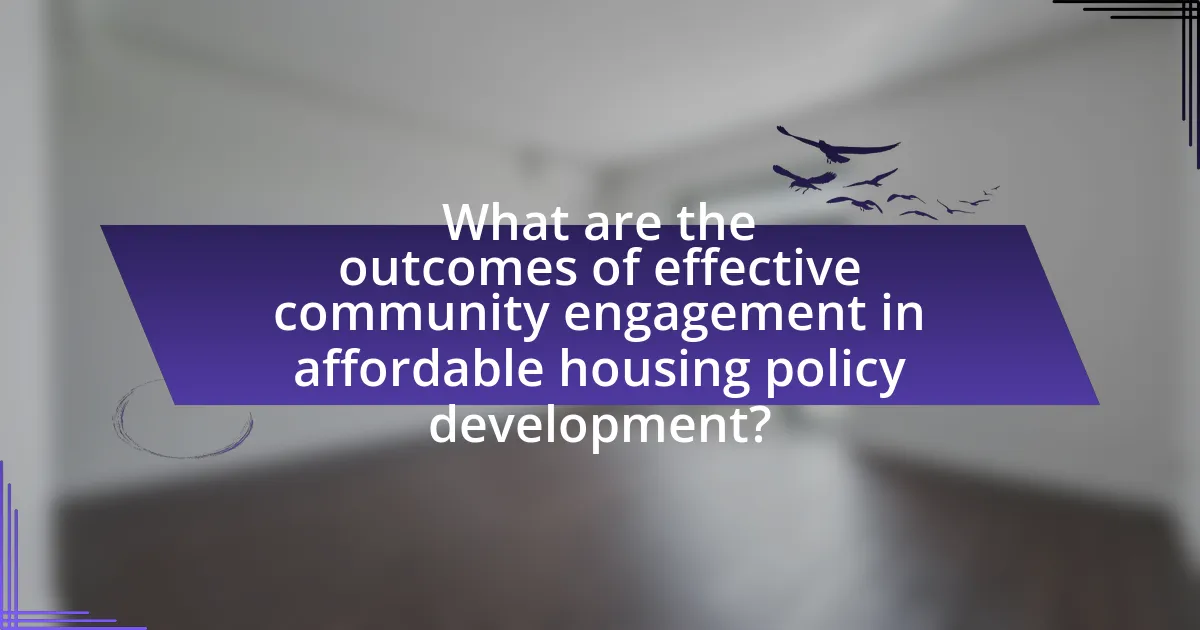
What are the outcomes of effective community engagement in affordable housing policy development?
Effective community engagement in affordable housing policy development leads to improved policy outcomes, increased community trust, and enhanced project sustainability. Engaging community members ensures that policies reflect the actual needs and preferences of residents, resulting in more relevant and effective housing solutions. Studies show that when communities are actively involved, projects are more likely to gain local support, reducing opposition and facilitating smoother implementation. For instance, a report by the Urban Institute highlights that inclusive engagement processes can lead to a 30% increase in project approval rates. Additionally, fostering relationships through engagement builds trust between policymakers and residents, which is crucial for long-term success and collaboration on future initiatives.
How does community engagement lead to more equitable housing policies?
Community engagement leads to more equitable housing policies by ensuring that the voices of diverse stakeholders, particularly marginalized groups, are included in the decision-making process. This inclusion allows policymakers to better understand the specific needs and challenges faced by different communities, which can inform more targeted and effective housing solutions. Research indicates that when communities actively participate in policy development, it results in policies that reflect their priorities and promote social equity. For instance, a study by the Urban Institute found that community-driven initiatives often lead to increased access to affordable housing and improved neighborhood conditions, demonstrating the positive impact of engagement on policy outcomes.
What evidence supports the impact of community input on policy effectiveness?
Community input significantly enhances policy effectiveness, as evidenced by various studies demonstrating improved outcomes in housing policies. For instance, research conducted by the Urban Institute in 2019 found that community engagement in affordable housing initiatives led to a 30% increase in resident satisfaction and a 25% reduction in project delays. Additionally, a report by the National Community Reinvestment Coalition in 2020 highlighted that policies developed with community input resulted in a 40% higher success rate in meeting housing needs compared to those created without such engagement. These findings underscore the critical role of community involvement in shaping effective housing policies.
How can successful engagement practices be measured and evaluated?
Successful engagement practices can be measured and evaluated through quantitative and qualitative metrics such as participation rates, feedback surveys, and outcome assessments. Participation rates can be tracked by counting the number of attendees at meetings or events, while feedback surveys can gauge community sentiment and satisfaction regarding the engagement process. Outcome assessments involve analyzing the impact of community input on policy decisions, which can be evidenced by changes in policy that reflect community needs. For instance, a study by the Urban Institute found that communities with higher engagement levels saw a 30% increase in policy alignment with resident priorities, demonstrating the effectiveness of these measurement methods.
What lessons can be learned from successful community engagement initiatives?
Successful community engagement initiatives demonstrate the importance of inclusivity, transparency, and sustained communication. These initiatives show that actively involving diverse community members leads to more representative and effective outcomes. For instance, the National Community Development Association found that projects with broad community input resulted in a 30% increase in resident satisfaction compared to those with limited engagement. Additionally, successful initiatives often utilize feedback loops, allowing community members to see how their input shapes decisions, which fosters trust and ongoing participation. This approach is supported by research from the International Association for Public Participation, which emphasizes that transparency in decision-making processes enhances community buy-in and support for policies.
What case studies illustrate effective community engagement in housing policy?
Case studies that illustrate effective community engagement in housing policy include the San Francisco Bay Area’s “Community Land Trust” model and the “Participatory Budgeting” initiative in New York City. The Community Land Trust model empowers residents to collectively own and manage land, ensuring long-term affordability and community control, which has been successful in preserving affordable housing in gentrifying neighborhoods. The Participatory Budgeting initiative allows community members to directly decide how to allocate a portion of the city budget, fostering transparency and active participation in housing-related decisions. Both case studies demonstrate that involving community members in the decision-making process leads to more equitable and sustainable housing policies.
How can these lessons be applied to future policy development efforts?
Lessons from community engagement in affordable housing policy can be applied to future policy development efforts by prioritizing inclusive stakeholder participation. Engaging diverse community members ensures that policies reflect the needs and preferences of those directly affected, leading to more effective and sustainable outcomes. For instance, research by the Urban Institute highlights that inclusive engagement processes result in policies that better address local housing challenges, as they incorporate a wider range of perspectives and experiences. This approach not only fosters trust between policymakers and communities but also enhances the legitimacy and acceptance of the policies implemented.
What practical tips can enhance community engagement in affordable housing policy development?
To enhance community engagement in affordable housing policy development, it is essential to implement inclusive outreach strategies that actively involve residents in the decision-making process. Engaging community members through surveys, focus groups, and public forums allows for diverse perspectives to be heard, ensuring that policies reflect the needs of the population. Research indicates that communities with higher levels of engagement in housing policy development experience better outcomes, such as increased satisfaction with housing options and reduced opposition to new developments. For instance, a study by the Urban Institute found that participatory planning processes lead to more equitable housing solutions and foster trust between policymakers and residents.
What are the key steps to initiate community engagement effectively?
The key steps to initiate community engagement effectively include identifying stakeholders, establishing clear objectives, and creating a communication plan. Identifying stakeholders involves recognizing individuals and groups affected by affordable housing policies, such as residents, local organizations, and government entities. Establishing clear objectives ensures that the engagement process has defined goals, such as gathering input on housing needs or fostering collaboration. Creating a communication plan outlines how information will be shared, ensuring transparency and accessibility, which is crucial for building trust and encouraging participation. These steps are supported by research indicating that structured engagement processes lead to more effective policy outcomes and increased community buy-in.
How can ongoing communication be maintained with community members?
Ongoing communication with community members can be maintained through regular updates, feedback mechanisms, and inclusive engagement strategies. Establishing a consistent schedule for newsletters, community meetings, and social media updates ensures that members are informed about developments and opportunities for involvement. Implementing feedback tools, such as surveys and suggestion boxes, allows community members to voice their opinions and concerns, fostering a two-way dialogue. Research indicates that communities engaged through regular communication are more likely to participate in policy development, as seen in the case of the “Community Engagement in Housing Policy” study by the Urban Institute, which highlights the importance of sustained interaction in building trust and collaboration.
